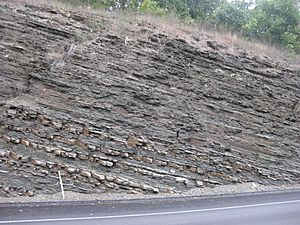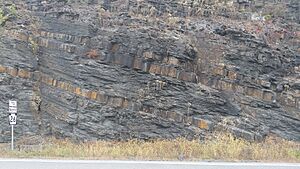Brallier Formation facts for kids
Quick facts for kids Brallier FormationStratigraphic range: Frasnian - Famennian |
|
|---|---|

Outcrop of Brallier Formation on north side of Pennsylvania Turnpike, central Bedford County, near Mile Marker 138
|
|
| Type | sedimentary |
| Sub-units | Black Creek Siltstone Member, Minnehaha Springs Member |
| Underlies | Greenland Gap Group and Scherr Formation |
| Overlies | Harrell Formation |
| Thickness | 1350 to 1800 feet in central PA |
| Lithology | |
| Primary | shale, sandstone |
| Location | |
| Region | Appalachian Mountains |
| Country | United States |
| Extent | Maryland, Pennsylvania, Virginia, and West Virginia |
| Type section | |
| Named by | Charles Butts, 1918 |
The Brallier Formation is a type of bedrock. It formed during the Devonian Period. You can find this rock unit in Pennsylvania, Maryland, West Virginia, and Virginia.
Contents
What is the Brallier Formation?
A scientist named Charles Butts first described the Brallier Formation in 1918. He found it in central Pennsylvania. It is mostly a fine-grained, sandy shale. It also has a few thin layers of fine-grained sandstone. Later, other scientists found similar rocks in nearby states. They also called these rocks the Brallier Formation.
How Does the Brallier Formation Fit with Other Rocks?
The Brallier Formation is similar to another rock unit called the Scherr Formation. This means they formed around the same time.
The Brallier Formation sits on top of the Harrell Formation. The change from the Harrell to the Brallier is gradual. This means the rock types slowly blend into each other. There isn't a sharp line between them.
What Fossils Are Found in the Brallier Formation?
Scientists have found several types of fossils in the lower parts of the Brallier Formation. These fossils help us learn about ancient life.
Here are some fossils found:
- Bivalves: These are sea creatures with two shells. Examples include Buchiola retrostriata, Paracardium doris, and Pterochaenia fragilis.
- Cephalopods: These are ocean animals like squids or octopuses. Bactrites and Orthoceras filosum are examples.
- Cricoconarida: These are a group of small mollusks with cone-shaped shells. Styliolina fissurella is one example.
- Annelids: These are segmented worms. Pteridichnites biseriatus is a trace fossil from an annelid.
Where Can You See the Brallier Formation?
The first place where the Brallier Formation was studied is called its "type locality." This spot is near a railway station. It is about 6 miles northeast of Everett in Bedford County, Pennsylvania.
You can also see a large section of the Brallier Formation in Huntingdon, Pennsylvania. It is visible along the ramp from U.S. Route 22 west to Route 26 north.
When Did the Brallier Formation Form?
Scientists use different methods to figure out the age of rocks. These methods show that the Brallier Formation formed during the late Devonian Period. This period was a very long time ago, millions of years in Earth's history.


